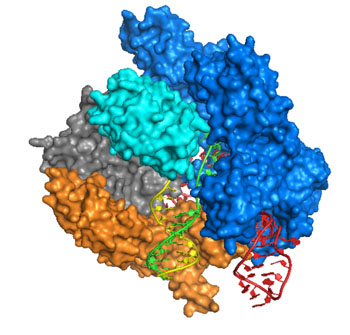Unrelated Single-Stranded DNA Increases Efficiency of CRISPR-Cas 9 Gene Editing
By LabMedica International staff writers
Posted on 29 Aug 2016
The addition of a short section of single-stranded DNA to the reaction mixture significantly enhances the efficiency of the CRISPR/Cas9 gene editing technique.Posted on 29 Aug 2016
CRISPRs (clustered regularly interspaced short palindromic repeats) are segments of prokaryotic DNA containing short repetitions of base sequences. Each repetition is followed by short segments of "spacer DNA" from previous exposures to a bacterial virus or plasmid. CRISPRs are found in approximately 40% of sequenced bacteria genomes and 90% of sequenced archaea. CRISPRs are often associated with cas genes that code for proteins related to CRISPRs. Since 2013, the CRISPR/Cas system has been used in research for gene editing (adding, disrupting, or changing the sequence of specific genes) and gene regulation. By delivering the Cas9 enzyme and appropriate guide RNAs (sgRNAs) into a cell, the organism's genome can be cut at any desired location. The conventional CRISPR/Cas9 system is composed of two parts: the Cas9 enzyme, which cleaves the DNA molecule and specific RNA guides that shepherd the Cas9 protein to the target gene on a DNA strand.

Image: The crystal structure of Cas9 bound to DNA (Photo courtesy of Wikimedia Commons).
In action, CRISPR-Cas9 gene editing is a competition between cutting of the target gene and the cell's DNA repair mechanism. After Cas9 slices out the target gene, the cell exactly replaces the cut DNA, which Cas9 then slices out again. This cycle of cut and repair continues until the repair enzymes make a mistake that cannot be corrected and the gene is rendered nonfunctional.
A paper published in the August 17, 2016, online edition of the journal Nature Communications described the use of a small segment of unrelated single-stranded DNA to increase the efficiency of the CRISPR/Cas 9 technique by shortening the number of cutting and repair cycles required to disable the target gene.
Investigators at the University of California, Berkeley (USA) had found that the frequency of error-prone repair tended to increase when single-stranded DNA was present in the editing reaction. Prompted by this observation, they undertook a systematic exploration of the parameters underlying DNA-mediated stimulation of error-prone repair events. To avoid confounding effects stemming from the use of plasmid or other nucleic acid-mediated delivery of Cas9, they performed editing experiments using nucleofection to directly introduce a ribonucleoprotein complex (RNP) of Cas9 complexed with sgRNA into cells.
Results revealed that the addition of non-homologous single-stranded DNA during Cas9-mediated gene targeting greatly increased the frequency of disrupting mutations in multiple human cell lines. Consequently, this dramatically increased the number of cells with homozygous gene disruptions within the edited population. Unrelated DNA appeared to drive cells towards error-prone instead of error-free repair pathways, thereby increasing the frequency of sequence disruption by 2.5 to five times during genome editing.
"It turns out that if you do something really simple - just feed cells inexpensive synthetic oligonucleotides that have no homology anywhere in the human genome - the rates of editing go up as much as five times," said senior author Dr. Jacob Corn, assistant adjunct professor of molecular and cell biology at the University of California, Berkeley. "It gives the cell a little kick to prevent normal repair from happening."
Related Links:
University of California, Berkeley









 assay.jpg)




